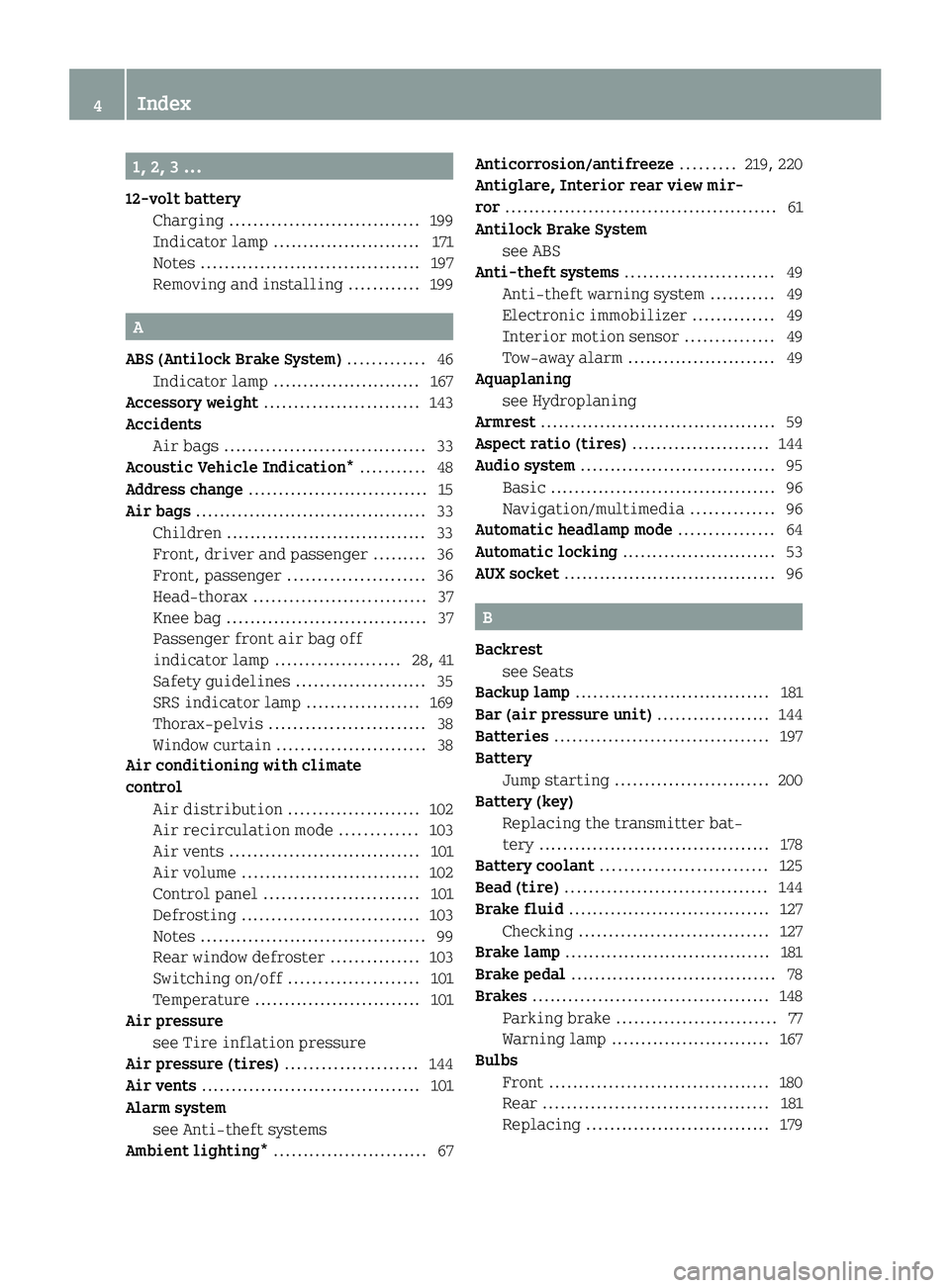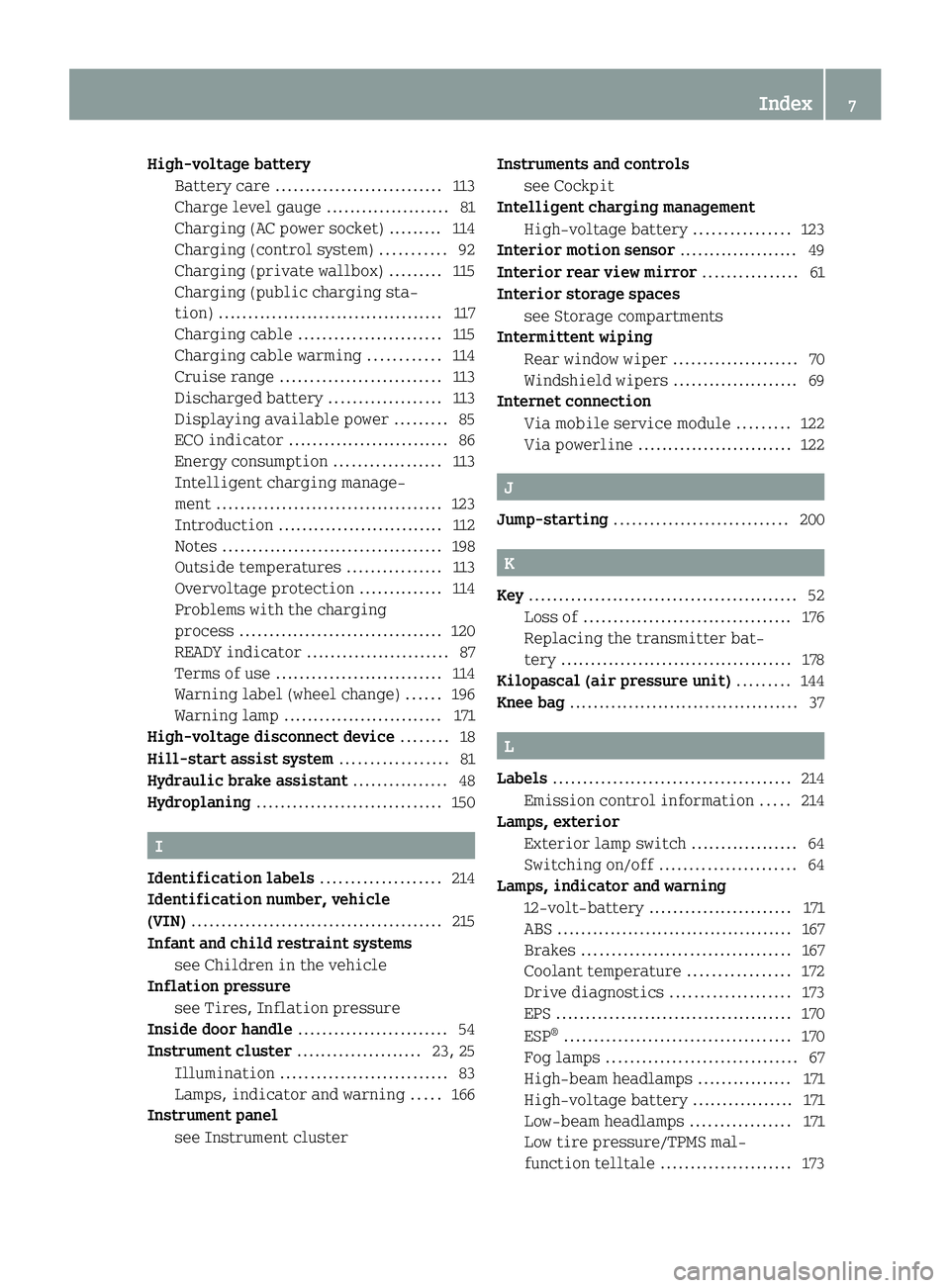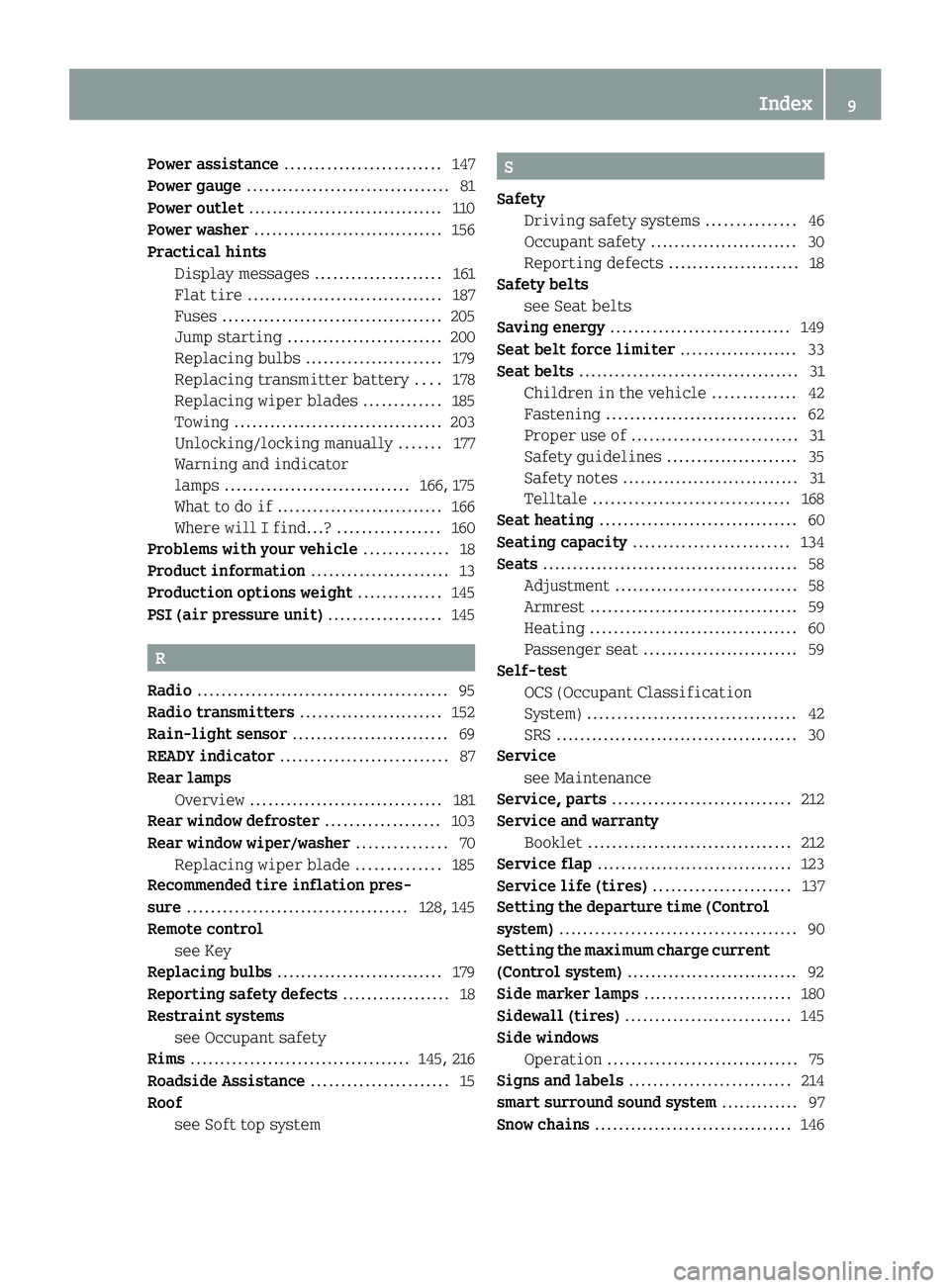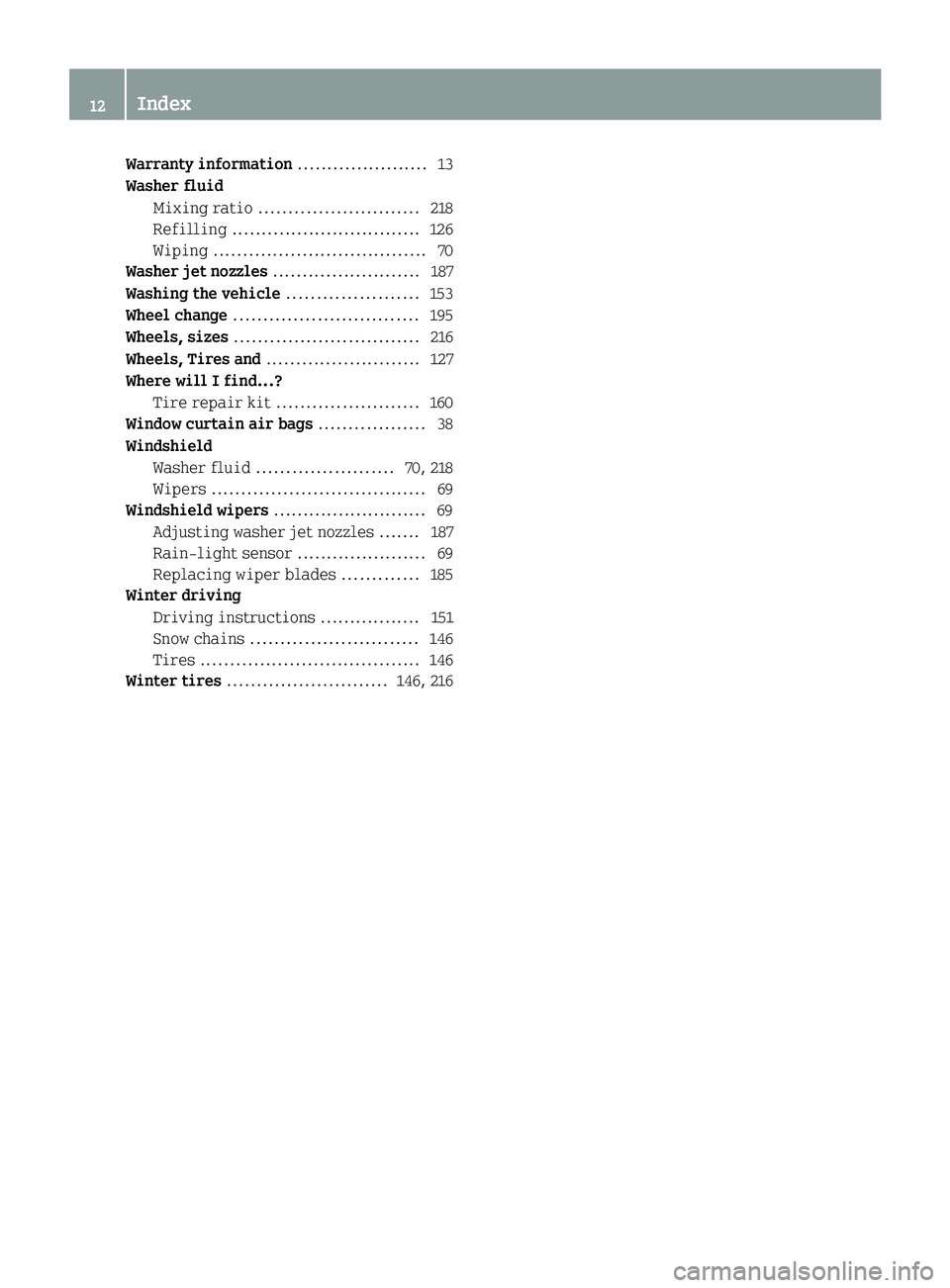sensor SMART FORTWO COUPE 2014 Owners Manual
[x] Cancel search | Manufacturer: SMART, Model Year: 2014, Model line: FORTWO COUPE, Model: SMART FORTWO COUPE 2014Pages: 222, PDF Size: 16.17 MB
Page 6 of 222

1, 2, 3 ...
12-volt battery Charging ................................ 199
Indicator lamp ........................ .171
Notes ..................................... 197
Removing and installing ............199 A
ABS (Antilock Brake System) .............46
Indicator lamp ......................... 167
Accessory weight .......................... 143
Accidents Air bags .................................. 33
Acoustic Vehicle Indication* ...........48
Address change .............................. 15
Air bags ....................................... 33
Children .................................. 33
Front, driver and passenger .........36
Front, passenger ....................... 36
Head-thorax ............................. 37
Knee bag .................................. 37
Passenger front air bag off
indicator lamp ..................... 28, 41
Safety guidelines ......................35
SRS indicator lamp ...................169
Thorax-pelvis .......................... 38
Window curtain ......................... 38
Air conditioning with climate
control
Air distribution ...................... 102
Air recirculation mode .............103
Air vents ................................ 101
Air volume .............................. 102
Control panel .......................... 101
Defrosting .............................. 103
Notes ...................................... 99
Rear window defroster ...............103
Switching on/off ...................... 101
Temperature ............................ 101
Air pressure
see Tire inflation pressure
Air pressure (tires) ......................144
Air vents ..................................... 101
Alarm system see Anti-theft systems
Ambient lighting* .......................... 67Anticorrosion/antifreeze
.........219, 220
Antiglare, Interior rear view mir-
ror .............................................. 61
Antilock Brake System see ABS
Anti-theft systems ......................... 49
Anti-theft warning system ...........49
Electronic immobilizer ..............49
Interior motion sensor ...............49
Tow-away alarm ......................... 49
Aquaplaning
see Hydroplaning
Armrest ....................................... .59
Aspect ratio (tires) .......................144
Audio system ................................. 95
Basic ...................................... 96
Navigation/multimedia ..............96
Automatic headlamp mode ................64
Automatic locking .......................... 53
AUX socket .................................... 96 B
Backrest see Seats
Backup lamp ................................. 181
Bar (air pressure unit) ...................144
Batteries .................................... 197
Battery Jump starting .......................... 200
Battery (key)
Replacing the transmitter bat-
tery ....................................... 178
Battery coolant ............................ 125
Bead (tire) .................................. 144
Brake fluid .................................. 127
Checking ................................ 127
Brake lamp ................................... 181
Brake pedal ................................... 78
Brakes ........................................ 148
Parking brake ........................... 77
Warning lamp ........................... 167
Bulbs
Front ..................................... 180
Rear ...................................... 181
Replacing ............................... 1794
Index
Page 9 of 222

High-voltage battery
Battery care ............................ 113
Charge level gauge ..................... 81
Charging (AC power socket) ......... 114
Charging (control system) ...........92
Charging (private wallbox) .........115
Charging (public charging sta-
tion) ...................................... 117
Charging cable ........................ 115
Charging cable warming ............114
Cruise range ........................... 113
Discharged battery ...................113
Displaying available power .........85
ECO indicator ........................... 86
Energy consumption ..................113
Intelligent charging manage-
ment ...................................... 123
Introduction ........................... .112
Notes ..................................... 198
Outside temperatures ................113
Overvoltage protection ..............114
Problems with the charging
process .................................. 120
READY indicator ........................ 87
Terms of use ............................ 114
Warning label (wheel change) ......196
Warning lamp ........................... 171
High-voltage disconnect device ........18
Hill-start assist system ..................81
Hydraulic brake assistant ................48
Hydroplaning ............................... 150I
Identification labels ....................214
Identification number, vehicle
(VIN) .......................................... 215
Infant and child restraint systems see Children in the vehicle
Inflation pressure
see Tires, Inflation pressure
Inside door handle ......................... 54
Instrument cluster .....................23, 25
Illumination ............................ 83
Lamps, indicator and warning .....166
Instrument panel
see Instrument cluster Instruments and controls
see Cockpit
Intelligent charging management
High-voltage battery ................123
Interior motion sensor .................... 49
Interior rear view mirror ................61
Interior storage spaces see Storage compartments
Intermittent wiping
Rear window wiper .....................70
Windshield wipers .....................69
Internet connection
Via mobile service module .........122
Via powerline .......................... 122 J
Jump-starting ............................. 200 K
Key ............................................. 52
Loss of ................................... 176
Replacing the transmitter bat-
tery ....................................... 178
Kilopascal (air pressure unit) .........144
Knee bag ....................................... 37 L
Labels ........................................ 214
Emission control information .....214
Lamps, exterior
Exterior lamp switch ..................64
Switching on/off ....................... 64
Lamps, indicator and warning
12-volt-battery ........................ 171
ABS ....................................... .167
Brakes ................................... 167
Coolant temperature .................172
Drive diagnostics ....................173
EPS ........................................ 170
ESP ®
...................................... 170
Fog lamps ................................ 67
High-beam headlamps ................1 71
High-voltage battery .................171
Low-beam headlamps .................171
Low tire pressure/TPMS mal-
function telltale ...................... 173 Index
7
Page 11 of 222

Power assistance
.......................... 147
Power gauge .................................. 81
Power outlet ................................. 110
Power washer ................................ 156
Practical hints Display message s..................... 161
Flat tire ................................. 187
Fuses ..................................... 205
Jump starting .......................... 200
Replacing bulbs ....................... 179
Replacing transmitter battery ....178
Replacing wiper blades .............185
Towing ................................... 203
Unlocking/locking manually .......177
Warning and indicator
lamps ............................... 166, 175
What to do if ............................ 166
Where will I find... ?................. 160
Problems with your vehicle ..............18
Product information .......................13
Production options weight ..............145
PSI (air pressure unit) ...................145 R
Radio .......................................... 95
Radio transmitters ........................ 152
Rain-light sensor .......................... 69
READY indicator ............................ 87
Rear lamps Overview ................................ 181
Rear window defroster ...................103
Rear window wiper/washer ...............70
Replacing wiper blade ..............185
Recommended tire inflation pres-
sure ..................................... 128, 145
Remote control see Key
Replacing bulbs ............................ 179
Reporting safety defects ..................18
Restraint systems see Occupant safety
Rims ..................................... 145, 216
Roadside Assistance .......................15
Roof see Soft top system S
Safety Driving safety systems ...............46
Occupant safety ......................... 30
Reporting defects ......................18
Safety belts
see Seat belts
Saving energy .............................. 149
Seat belt force limiter .................... 33
Seat belts ..................................... 31
Children in the vehicle ..............42
Fastening ................................ 62
Proper use of ............................ 31
Safety guidelines ......................35
Safety notes .............................. 31
Telltale ................................. 168
Seat heating ................................. 60
Seating capacity .......................... 134
Seats ........................................... 58
Adjustment ............................... 58
Armrest ................................... 59
Heating ................................... 60
Passenger seat .......................... 59
Self-test
OCS (Occupant Classification
System) ................................... 42
SRS ......................................... 30
Service
see Maintenance
Service, parts .............................. 212
Service and warranty Booklet .................................. 212
Service flap ................................. 123
Service life (tires) .......................137
Setting the departure time (Control
system) ........................................ 90
Setting the maximum charge current
(Control system) ............................. 92
Side marker lamps ......................... 180
Sidewall (tires) ............................ 145
Side windows Operation ................................ 75
Signs and labels ........................... 214
smart surround sound system .............97
Snow chains ................................. 146 Index
9
Page 14 of 222

Warranty information
......................13
Washer fluid Mixing ratio ........................... 218
Refilling ................................ 126
Wiping .................................... 70
Washer jet nozzles ......................... 187
Washing the vehicle ......................153
Wheel change ............................... 195
Wheels, sizes ............................... 216
Wheels, Tires and .......................... 127
Where will I find...? Tire repair kit ........................ 160
Window curtain air bags ..................38
Windshield Washer fluid ....................... 70, 218
Wipers .................................... 69
Windshield wipers .......................... 69
Adjusting washer jet nozzles .......1 87
Rain-light sensor ..................... .69
Replacing wiper blades .............185
Winter driving
Driving instructions ................. 151
Snow chains ............................ 146
Tires ..................................... 146
Winter tires ........................... 146, 21612
Index
Page 29 of 222

Center console
Function Page
0043
Charge level gauge 81
0044
Power gauge 81
0087
Air conditioning with
climate control 99
0085
Radio 95
0083
Drawer 107
0084
Switching seat heating*
on/off
60
006B
Restarting TPMS button 131
006C
Switching tow-away pro-
tection*/interior motion
sensor* on/off
49
006D
Central unlocking switch
53 Function Page
006E
Hazard warning flasher
switch
68
006F
Central locking switch 53
0070
Switching front fog
lamps* on/off
67
0071
Storage tray* 107
0072
Gear selector lever 79
0073
Starter switch 57
0074
Parking brake lever 77
0075
Coin holder 106
Retractable soft top
switch
2 72
2
cabriolet only. Center console
27>> At a glance.
* optional
Page 38 of 222

SRS indicator lamp
0075in the instrument
cluster illuminates.
! If the air bags are activated, you will
hear a loud noise and some dust may be
generated. The explosion fundamentally
represents no risk to your hearing.
An inflated air bag slows down and reduces
the movement of the occupant. When the
occupant makes contact with a front air bag
or head-thorax air bag (cabriolet only),
hot gas flows out of the inflated front air
bags and head-thorax air bags (cabriolet
only). This reduces the load on the occu-
pant’s head and upper body. These air bags
are consequently deflated after the acci-
dent.
Driver front air bag/passenger front air
bag The front air bags are designed to reduce
the potential of injury in certain frontal
impacts.
Driver front air bag and passenger front
air bag are deployed
R at the start of an accident with high
vehicle deceleration in the longitudinal
direction
R independently of other air bags in the
vehicle being deployed
R never in the event of a rollover, unless
high vehicle deceleration in the longi-
tudinal direction is detected
i The front air bags in this vehicle have
been designed to inflate in two stages.
This allows the air bag to have different
rates of inflation that are based on the
rate of relevant vehicle deceleration
and a fastened or unfastened seat belt as
assessed by the air bag control unit.
On the passenger side, the front air bag
deployment is additionally influenced
by the passenger’s weight category as
identified by the Occupant Classifica-
tion System (OCS) (Y page 39). The lighter the passenger side occupant,
the higher the vehicle deceleration rate
required for the second stage inflation
of the air bag.
The air bags will not deploy in impacts
which do not exceed the system’s deploy-
ment thresholds. In such instances, the seat
belts are designed to protect you.
The passenger air bag will only be
deployed if
R the system, based on OCS weight sensor
readings, senses that the passenger seat
is occupied and the 0073006F
indicator lamp is not lit (Y page 41)
R the impact exceeds a preset deployment
threshold
The driver front air bag is located in the
steering wheel housing, the passenger
front air bag above the glove box. 0043
Driver front air bag
0044 Passenger front air bag 36
Occupant safety>> Safety.
Page 41 of 222

Thorax-pelvis side air bags
Thorax-pelvis side air bags are designed
to provide increased protection for the
thorax and pelvis, but not the arms.
Thorax-pelvis side air bags are deployed
R on the impacted side of the vehicle
R in instances with a high rate of lateral
vehicle deceleration or acceleration
R independently of the front air bags
R regardless of whether the seat belt on the
impacted side of the vehicle is in use
R independently of the ETDs.
Thorax-pelvis side air bags will generally
not deploy in a rollover.
The thorax-pelvis side air bags will
deploy, however, if the system detects
R a high rate of lateral vehicle decelera-
tion or acceleration, and
R that air bag deployment can offer addi-
tional protection to that provided by the
seat belt.
The thorax-pelvis side air bags are inte-
grated into the driver and passenger seat
backrests. 0043
Thorax-pelvis side air bags Occupant Classification System
The Occupant Classification System (OCS)
automatically turns the passenger front air
bag on or off based on the classified occu-
pant weight category determined by weight
sensor readings from the passenger seat. i
Based on the classified occupant
weight category determined by weight
sensor readings from the passenger seat,
the system does also deactivate
R head-thorax air bag (cabriolet)
R the window curtain air bag (coupé)
R the thorax-pelvis side air bag (coupé)
R the seat Emergency Tensioning Devi-
ces
R the seat belt force limiter.
Occupants must sit properly belted in a
position that is as upright as possible with
their back against the seat backrest and
feet on the floor to be correctly classified.
If the occupant’s weight is transferred to
another object in the vehicle (e.g. by lean-
ing on armrests), the OCS may not be able to
properly approximate the occupant’s
weight category.
i If the seat, including the trim cover and
cushion, needs to be serviced in any way,
take the vehicle to an authorized elec-
tric drive smart center. Only seat acces-
sories approved by smart may be used.
Both driver and the passenger should
always use the 0073006Findicator
lamp as an indication of whether or not
the passenger is properly positioned
(Y page 41). G
WARNING
If the 0073006Findicator lamp illu-
minates when an adult or someone larger
than a small individual is in the passenger
seat, have the passenger re-position him-
self or herself in the seat until the
0073006Findicator lamp goes out.
In the event of a collision, the air bag
control unit will not allow passenger front
air bag deployment when the OCS has clas-
sified the passenger seat occupant as
being up to or less than the weight of a typ-
ical 12‑month‑old child in a standard child
restraint, or if the passenger seat is
sensed as being empty. Occupant safety
39>> Safety.
Z
Page 42 of 222

When the OCS senses that the passenger seat
occupant is classified as being up to or
less than the weight of a typical
12‑month‑old child in a standard child
restraint, the 0073006Findicator
lamp will illuminate when the ignition is
switched on and remain illuminated, indi-
cating that the passenger front air bag is
deactivated.
When the OCS senses that the passenger seat
is classified as being empty, the
0073006Findicator lamp will illu-
minate and remains illuminated.
When the OCS senses that the passenger seat
occupant is classified as being heavier
than the weight of a typical 12‑month‑old
child seated in a standard child restraint
or as being a small individual (such as a
young teenager or a small adult), the
0073006Findicator lamp will illu-
minate for approximately 4 seconds when
the ignition is switched on and then,
depending on occupant weight sensor read-
ings from the seat, remains illuminated or
goes out.
When the 0073006Findicator lamp is
illuminated, the passenger front air bag is
deactivated.
When the 0073006Findicator lamp is
out and the passenger seat is occupied by
an adult or someone larger than a small
individual, the passenger front air bag is
activated.
When the OCS senses that the passenger seat
occupant is classified as an adult or some-
one larger than a small individual, the
0073006Findicator lamp will illu-
minate for approximately 4 seconds when
the ignition is switched on and then goes
out, indicating that the passenger front air
bag is activated.
If the 0073006Findicator lamp is
illuminated, the passenger front air bag is
deactivated and will not be deployed. If the
0073006Findicator lamp is not
illuminated, the passenger front air bag is
activated and will be deployed
R in the event of certain frontal impacts
R if impact exceeds a preset deployment
threshold
R independently of the head-thorax air
bags
If the passenger front air bag is deployed,
the rate of inflation will be influenced by
R the rate of vehicle deceleration and a
fastened or unfastened seat belt as
assessed by the air bag control unit
R the passenger’s weight category as iden-
tified by the OCS G
WARNING
Children 12 years old and under must be
seated and properly secured in an appro-
priate infant or child restraint recom-
mended for the size and weight of the child.
The infant or child restraint must be prop-
erly secured with the vehicle’s seat belt,
fully in accordance with the child seat
manufacturer’s instructions.
Children can be killed or seriously injured
by an inflating air bag. Note the following
important information:
R Your vehicle is equipped with air bag
technology designed to turn off the
passenger front air bag in your vehicle
when the system senses the weight of a
typical 12‑month‑old child or less along
with the weight of a standard appropri-
ate child restraint on the passenger seat.
R A child in a rear-facing child restraint
on the passenger seat will be seriously
injured or even killed if the passenger
front air bag inflates in a collision
which could occur under some circum-
stances, even with the air bag technology
installed in your vehicle.
R If you install a rear-facing child
restraint on the passenger seat, make 40
Occupant safety>> Safety.
Page 51 of 222

Anti-theft systems
Electronic immobilizer
The electronic immobilizer prevents
unauthorized persons from starting your
vehicle.
When leaving the vehicle, always take the
key with you and lock the vehicle. The drive
system can be switched on by anyone with a
key that is left inside the vehicle.
X Activating: Remove the key from the
starter switch.
X Deactivating: Insert the key in the
starter switch.
X Turn the key to starter switch position 1.Anti-theft warning system*
Once the anti-theft warning system has
been armed, a visual and audible alarm is
triggered when
R someone opens a door or the tailgate
R someone enters the vehicle’s interior
R there is motion inside the vehicle
R someone attempts to raise the vehicle
The alarm will also be triggered when
unlocking and opening the driver’s door
with the key.
i The alarm will stay on, even if the
driver’s door is immediately closed. For
canceling the alarm, see (Y page 49).
Close the windows and the tailgate before
arming the alarm system. Make sure there
are no moving objects inside the vehicle. X
Arming: Lock the vehicle using the
remote control.
Warning system indicator lamp 0043
flashes rapidly. The anti-theft warning
system arms after about 25 seconds. When
the anti-theft warning system is armed,
warning system indicator lamp 0043
flashes about every three seconds.
i You can also arm the anti-theft warning
system by locking the vehicle without
using the remote control (Y page 177).
X Disarming: Unlock the vehicle using the
remote control.
The anti-theft warning system is dis-
armed. Warning system indicator
lamp 0043stops flashing.
Canceling the alarm X
Insert the key in the starter switch.
X Turn the key to starter switch position 1.
or
X Press button 0034or0038 on the key. Tow-away alarm* and interior motion
sensor*
Once the anti-theft warning system has
been armed, a visual and audible alarm is
triggered when someone attempts to raise
the vehicle or if motion is detected inside
the vehicle. Anti-theft systems
49>> Safety.
* optional Z
Page 52 of 222

X
Arming: Lock the vehicle using the
remote control.
The tow-away protection and the interior
motion sensor are armed after about
25 seconds.
X Disarming: Unlock the vehicle using the
remote control.
The tow-away protection and the interior
motion sensor are disarmed.
Canceling the alarm X
Insert the key in the starter switch.
X Turn the key to starter switch position 1.
or
X Press button 0034or0038 on the key.
Switching off tow-away protection and
interior motion sensor Switch off the tow-away protection and the
interior motion sensor when locking the
vehicle and
R transporting the vehicle,
R board, e.g. a ferry or auto train,
R there are people or animals in the vehi-
cle,
R the side windows remain open.
This prevents any false alarm. X
Remove the key from the starter switch.
X Press switch 0043within 60 seconds.
Indicator lamp 0044comes on. X
Exit the vehicle.
X Lock the vehicle using the remote
control.
i The tow-away protection and the inter-
ior motion sensor remain switched off
until you lock your vehicle again. 50
Anti-theft systems>> Safety.